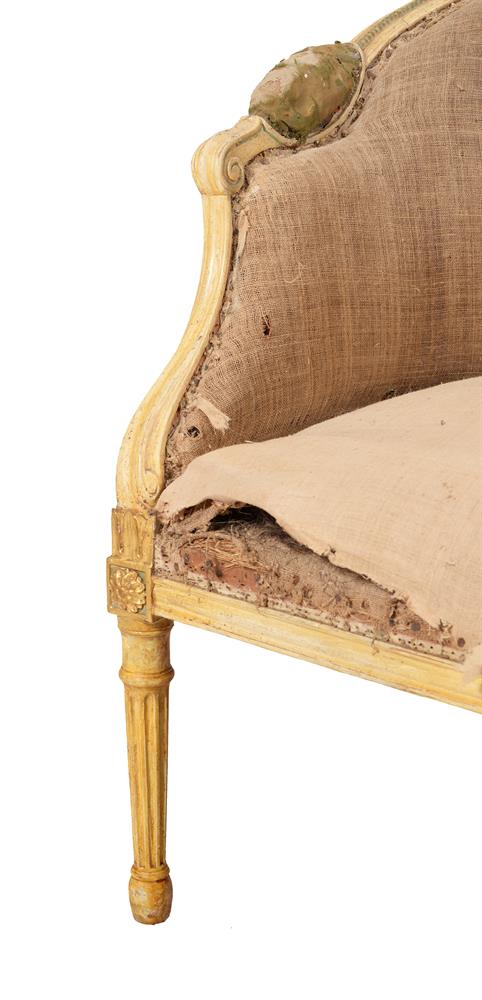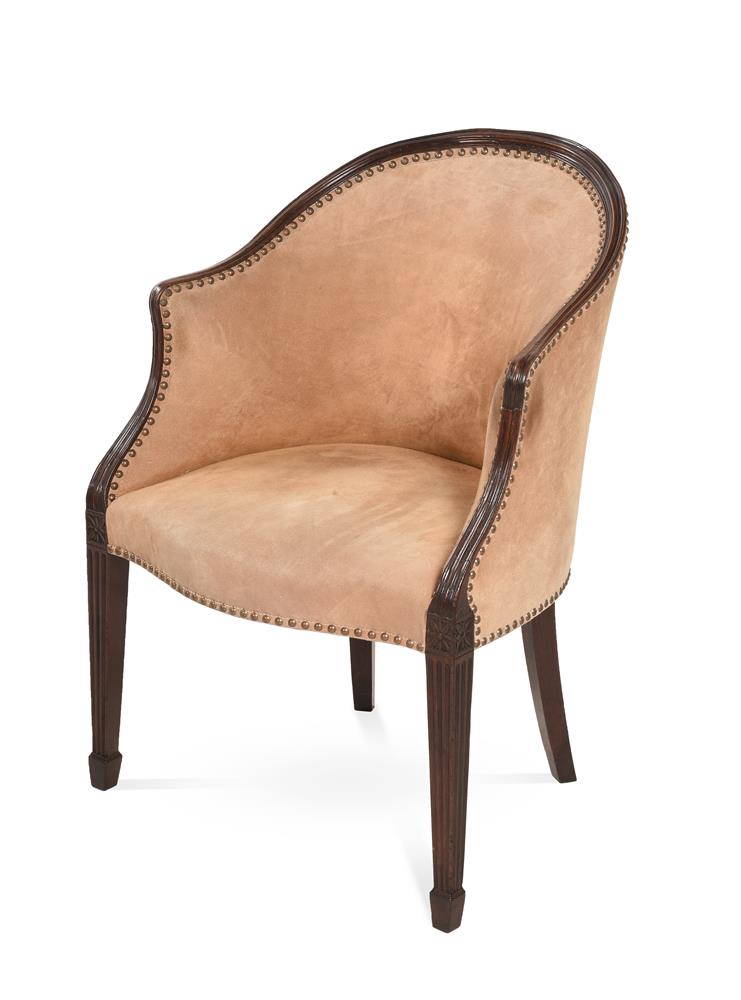A PAIR OF GEORGE II CARVED AND PAINTED PEDESTALS MID 18TH CENTURY, POSSIBLY BY WILLIAM HALLETT (1730-1767) The serpentine tops with paterae and riband moulding above acanthus carved shaped bodies above egg and dart moulded plinths Each 44cm high, 62cm wide, 37cm deep Provenance: The Saloon Brightling Park (then known as Rosehill House) Reputedly commissioned by John Fuller (1706-1755) for the Drawing Room at Brightling Park Sussex, circa 1747 Thence by descent to his brother Rose Fuller (1708-1777) to his nephew John (Mad Jack) Fuller (1757-1834) inherited by his cousin Augustus Fuller in 1834 acquired by Percy Tew, in 1879, when he purchased the house (and renamed it Brightling Park) by descent to his son Thomas Percy Tew (d. 1853) in 1921 thence to his daughter-in law Rosemary Grissell, window of Lieut. Thomas Tew (d. 1940) and thence by descent at Brightling Park until sold Bonhams London 2nd March 2011, lot 95. The pair of stands was recorded in situ in the Drawing Room at Brightling Park during the mid-20th century (see photograph reproduced from the Grissell family album, Bonhams Catalogue 2nd March 2011, p.76) where they are shown in niches either side of the bay window. Although they are seen supporting large Chinese vases, they originally would have been made for large statues supplied by Sir Henry Cheere John Fuller's journal records a payment of £139 to 'Henry Chere for statuary' on July 11th 1747 (East Sussex Record Office SAS/RF/15/29). The pedestals' possible association with William Hallett is based on a series of six separate payments to him amounting to £488 over a seven year period 1746-1753, the majority of which coincided with the remodelling of the house (see payments drawn from Bank of England Account and paid to 'Hallett' recorded in John Fuller's journal for 1745-1756 East Sussex Record Office SAS/RF 15/29). Stylistic comparisons with Hallett's commissions for carved interiors at The Foundling Hopsital, London, Kirtlington Park in Oxfordshire and the Drawing Room at Brightling Park. In addition decorative elements such as the trussed scrolls and cherubs' heads in the Drawing Room at Brightling Park correspond with furniture traditionally attributed to William Hallett It should be noted that when the pedestals were entirely white when sold at Bonhams, and have subsequently been partially dry-stripped to reveal an earlier pale green ground colour to the white painted carved elements. The History of Brightling Park Brightling Park was acquired by the iron master and gun-founder John Fuller (1680-1745) in 1705 and shortly after he renamed it 'Rosehill' in honour of his wife Elizabeth Rose, heiress of Fulke Rose of Jamaica. On the death of John Fuller, the property passed to his son John II who embarked on substantial remodelling of the house and augmenting of the estate by almost 400 hectares. John II's younger brother Rose Fuller was the next to inherit the property but did little to the house, preferring to concentrate on his political career until his death in 1777 when title of the house transferred to his nephew and most famous inhabitant known as either 'Mad Jack' or 'Honest John' Fuller (1757-1833) who employed Robert Smirke to extend the house between 1810 and 1812 as well as build garden follies including a temple and observatory. This augmented the landscaping work to the Park after designs by Humphry Repton carried out two years earlier. When John Fuller III died the house was inherited by his cousing Augustus Fuller who let the house to tenants until he sold it in 1879 to Percy Tew whose family retained ownership until it passed to the Grissells who were related by marriage. Unfortunately the part of the house that contained the Drawing Room was demolished in 1955 to pay death duties. Condition Report: Marks, scratches, chips, splits and abrasions consistent with age and use. Cracks along construction joints. Some repairs. The backs cut to sit flush with a skirting board. Evidence of old worm.
A PAIR OF GEORGE II CARVED AND PAINTED PEDESTALS MID 18TH CENTURY, POSSIBLY BY WILLIAM HALLETT (1730-1767) The serpentine tops with paterae and riband moulding above acanthus carved shaped bodies above egg and dart moulded plinths Each 44cm high, 62cm wide, 37cm deep Provenance: The Saloon Brightling Park (then known as Rosehill House) Reputedly commissioned by John Fuller (1706-1755) for the Drawing Room at Brightling Park Sussex, circa 1747 Thence by descent to his brother Rose Fuller (1708-1777) to his nephew John (Mad Jack) Fuller (1757-1834) inherited by his cousin Augustus Fuller in 1834 acquired by Percy Tew, in 1879, when he purchased the house (and renamed it Brightling Park) by descent to his son Thomas Percy Tew (d. 1853) in 1921 thence to his daughter-in law Rosemary Grissell, window of Lieut. Thomas Tew (d. 1940) and thence by descent at Brightling Park until sold Bonhams London 2nd March 2011, lot 95. The pair of stands was recorded in situ in the Drawing Room at Brightling Park during the mid-20th century (see photograph reproduced from the Grissell family album, Bonhams Catalogue 2nd March 2011, p.76) where they are shown in niches either side of the bay window. Although they are seen supporting large Chinese vases, they originally would have been made for large statues supplied by Sir Henry Cheere John Fuller's journal records a payment of £139 to 'Henry Chere for statuary' on July 11th 1747 (East Sussex Record Office SAS/RF/15/29). The pedestals' possible association with William Hallett is based on a series of six separate payments to him amounting to £488 over a seven year period 1746-1753, the majority of which coincided with the remodelling of the house (see payments drawn from Bank of England Account and paid to 'Hallett' recorded in John Fuller's journal for 1745-1756 East Sussex Record Office SAS/RF 15/29). Stylistic comparisons with Hallett's commissions for carved interiors at The Foundling Hopsital, London, Kirtlington Park in Oxfordshire and the Drawing Room at Brightling Park. In addition decorative elements such as the trussed scrolls and cherubs' heads in the Drawing Room at Brightling Park correspond with furniture traditionally attributed to William Hallett It should be noted that when the pedestals were entirely white when sold at Bonhams, and have subsequently been partially dry-stripped to reveal an earlier pale green ground colour to the white painted carved elements. The History of Brightling Park Brightling Park was acquired by the iron master and gun-founder John Fuller (1680-1745) in 1705 and shortly after he renamed it 'Rosehill' in honour of his wife Elizabeth Rose, heiress of Fulke Rose of Jamaica. On the death of John Fuller, the property passed to his son John II who embarked on substantial remodelling of the house and augmenting of the estate by almost 400 hectares. John II's younger brother Rose Fuller was the next to inherit the property but did little to the house, preferring to concentrate on his political career until his death in 1777 when title of the house transferred to his nephew and most famous inhabitant known as either 'Mad Jack' or 'Honest John' Fuller (1757-1833) who employed Robert Smirke to extend the house between 1810 and 1812 as well as build garden follies including a temple and observatory. This augmented the landscaping work to the Park after designs by Humphry Repton carried out two years earlier. When John Fuller III died the house was inherited by his cousing Augustus Fuller who let the house to tenants until he sold it in 1879 to Percy Tew whose family retained ownership until it passed to the Grissells who were related by marriage. Unfortunately the part of the house that contained the Drawing Room was demolished in 1955 to pay death duties. Condition Report: Marks, scratches, chips, splits and abrasions consistent with age and use. Cracks along construction joints. Some repairs. The backs cut to sit flush with a skirting board. Evidence of old worm.





.jpg)









Testen Sie LotSearch und seine Premium-Features 7 Tage - ohne Kosten!
Lassen Sie sich automatisch über neue Objekte in kommenden Auktionen benachrichtigen.
Suchauftrag anlegen